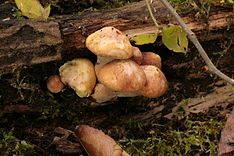Gymnopilus braendlei
Appearance
| Gymnopilus braendlei | |
|---|---|

| |
| Scientific classification | |
| Kingdom: | |
| Division: | |
| Class: | |
| Order: | |
| Family: | |
| Genus: | |
| Species: | G. braendlei
|
| Binomial name | |
| Gymnopilus braendlei | |
| Synonyms[1] | |
|
Flammula braendlei Peck (1904) | |
| Gymnopilus braendlei | |
|---|---|
| Cap is convex | |
| Hymenium is adnexed or adnate | |
| Spore print is yellow-orange | |
| Ecology is saprotrophic | |
| Edibility is psychoactive | |
Gymnopilus braendlei is a species of agaric fungus that contains the hallucinogens psilocybin and psilocin.[2] It was originally collected by mycologist Charles Horton Peck as Flammula braendlei in the District of Columbia near Washington (1902).
Description
- Pileus: 2.5 – 5 cm, hemispheric becoming convex, sometimes slightly umbilicate, hygrophanous, purplish when young then pinkish and lighter towards the margin, becoming yellowish in age with greenish stains, fibrillose, sometimes squamulose toward the center, flesh whitish, thin, staining greenish.
- Gills: Adnate, sometimes slightly sinuate in attachment, broad, close, whitish when young, becoming bright orangish brown to mustard yellow, becoming bright orangish brown in age.
- Spore Print: Orangish brown.
- Stipe: 2.5 – 4 cm x 3 – 4 cm thick, more or less equal, pallid, sometimes yellowish at the base, fibrillose above, stuffed or hollow, veil fibrillose, sometimes leaving a silky zone but not forming an annulus.
- Taste: Bitter
- Microscopic features: Spores 6 x 8.5 x 4.5 — 5 µm ellipsoid to ovoid in face view, dextrinoid, verruculose, no germ pore. Pleurocystidia 22— 33 x 6— 7 µm, cheilocystidia 20 — 34 x 3 — 7 µm, caulocystidia none, clamp connections present.
- Bruising: Green or blue bruising at the base or on the pileus (cap), and green spots on pileus likely.
Distribution and habitat
Gymnopilus braendlei is found growing solitary or cespitose on tree stumps, June - November. It is widespread in the eastern U.S, and present in the western U.S.
See also
References
- ^ "Gymnopilus braendlei (Peck) Singer :561, 1951". MycoBank. International Mycological Association. Retrieved 2013-01-02.
- ^ A Worldwide Geographic Distribution of the Neurotropic Fungi
- Peck CH. (1904). New species of fungi. Bulletin of the Torrey Botanical Club 31(4): 177-182.
- Hesler, L. R. (1969). North American species of Gymnopilus. New York: Hafner. 117 pp.
